Winter RV camping is more accessible than ever with improvements in RV technology. That’s why more people seek winter destinations for RV getaways and live in RVs full-time during all four seasons.
If you camp in the cold, you’ll need to prepare for it. If you’ll be camping in cold temperatures this winter, here’s what you need to know to keep your RV and yourself healthy and happy.
How to Get Water For Winter RV Camping
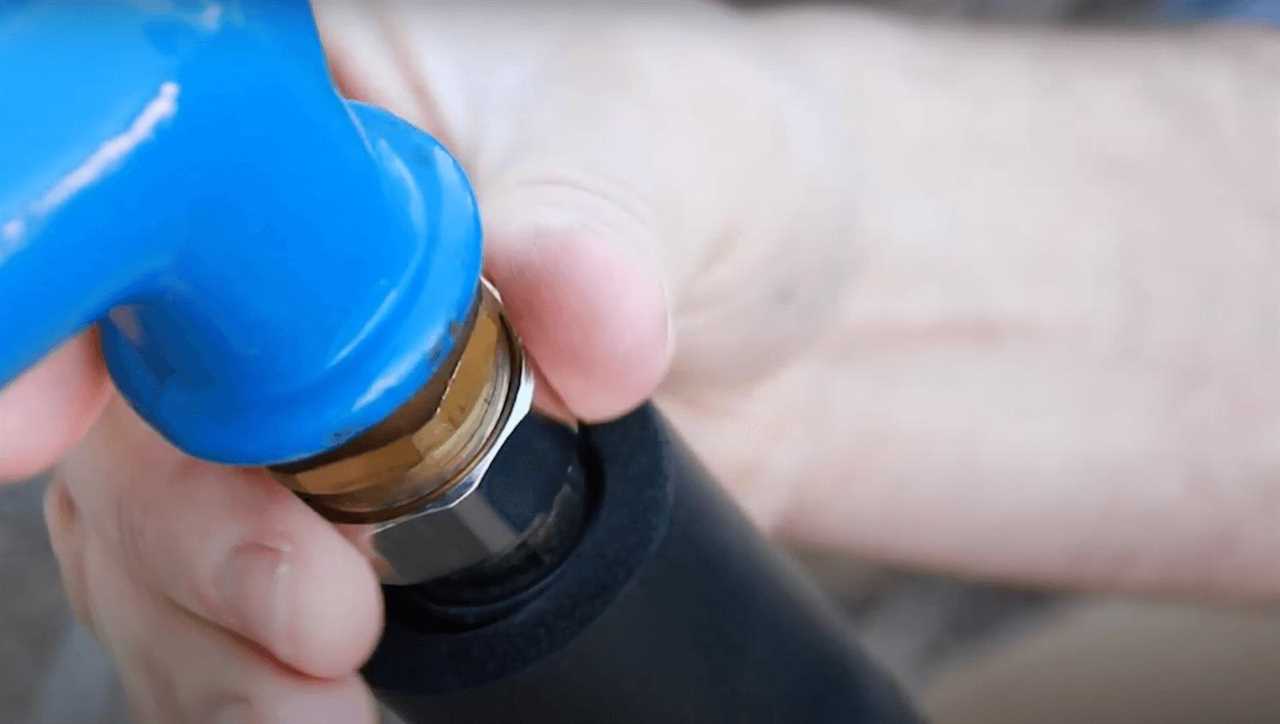
Photo by Camco
Maintaining the health of your RV’s water system is arguably the most important factor of winter RV camping. Getting clean drinking water for your RV is always important, but when outside temperatures drop below freezing, water can freeze in your pipes and your freshwater hose.
Frozen water expands, which can cause your pipes to burst. Even if your pipes don’t freeze completely, a frozen section can increase water pressure enough to stress pipe joints to the point of bursting.
Unregulated water pressure will lead to major repairs when you don’t want to be working on your motorhome or travel trailer. Repairing your RV’s plumbing also comes with a hefty bill. Avoid the expense with a little preparation.
Winter Considerations When Hooking Up to City Water
If you’re hooking up to city water, you’ll need a heated hose that plugs into an AC outlet in your RV or at your campsite. A heated hose keeps water from freezing at the source while it’s flowing into your RV.
There are many designs, but we recommend the Camco Freeze Ban hose because it comes with insulated sleeves that slide over the hose fittings at the inlet and outlet. It’s also rated for temperatures down to -20℉. Learn more about this Camco insulated water hose.
Some people add insulation to their heated hoses if they know temperatures will remain below freezing for long stretches. This can be done by wrapping the entire length of the hose in foil or foam insulation tape.
Technician Tip: Check the recommendations and read through the manual that came with your heated hose before adding insulation.
Winter Considerations When Filling Your Freshwater Tank
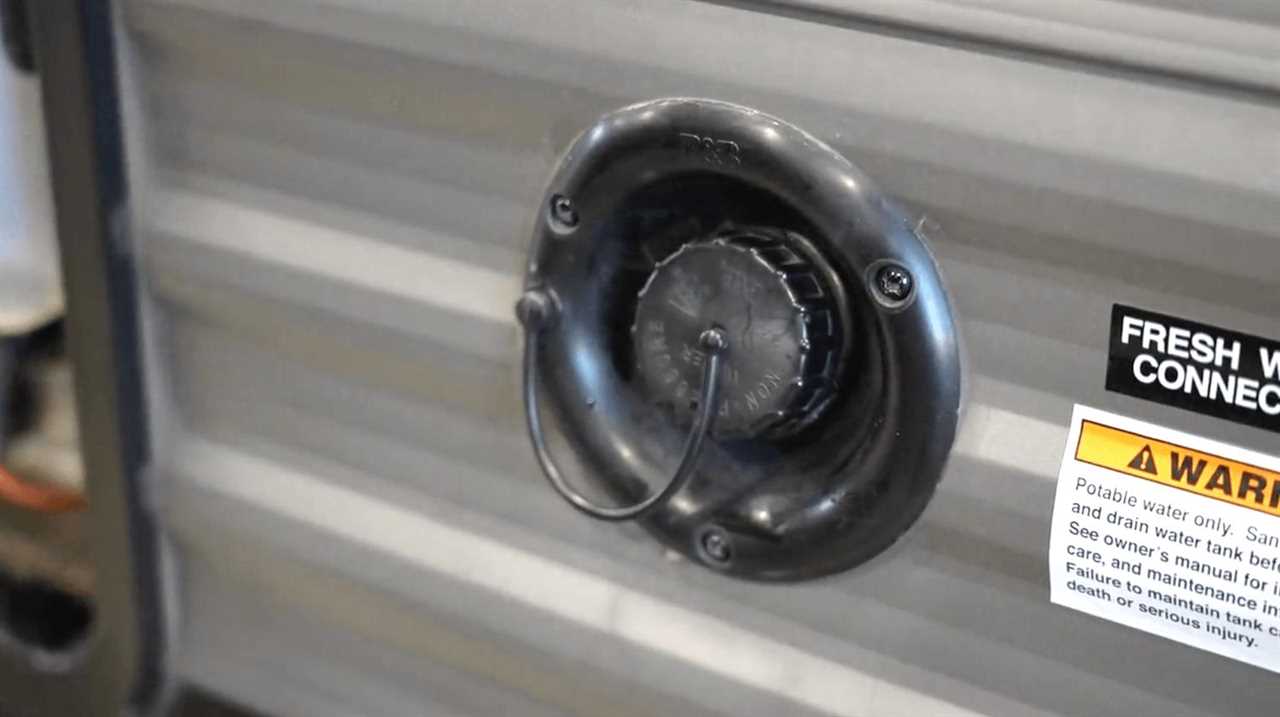
Photo by Camping World
If you don’t have a heated hose, you can fill your freshwater tank instead of connecting to city water. Many modern RVs designed for winter camping feature heated holding tank compartments to prevent water from freezing in your tanks.
For older RVs, you can add your own insulation to your holding tank compartments or place a drop light in the compartment. The heat produced by the light will be enough to keep the water in your tank from freezing unless you encounter extremely cold temperatures.
Technician Tip: Drop lights must use incandescent bulbs rather than LED or fluorescent bulbs to produce heat to warm your tanks. Extreme caution should be exercised, so heat doesn’t damage the coach or start a fire.
As a rule of thumb, only connect your water hose when filling your freshwater tank. Disconnect it when you’re finished, and drain all water out of the hose before storing it. This will prolong the tank’s life and the hose while preventing potential freezing.
How to Keep RV Pipes from Freezing While Camping

Photo by Camping World
So you’ve got running water into your RV – excellent, but you’re not out of the woods yet. To keep your RV pipes from freezing, open cabinets, so the heat from your furnace heats your entire coach. You can also leave faucets barely open, so they drip overnight, but this runs the risk of overfilling your grey water holding tank while you’re sleeping.
Some RVs come with heated holding tank compartments, and you can add a tank blanket if yours doesn’t. Tank blankets are typically available in 12V DC and 120V AC models, allowing you to choose one that suits your off-grid or on-grid winter RV camping trips.
Technician Tip: It’s best to consult with a local Camping World specialist for assistance on modifications to avoid adding a heater that damages your plumbing.
Additionally, many towable RVs have exposed water lines underneath the unit. These are the most likely candidates for freezing when camping in cold temperatures. An easy way to reduce the risk of exposed water lines freezing is to add foam pipe insulation and wrap it with foam insulation or heat tape.
How to Keep Your RV Sewer Hose from Freezing
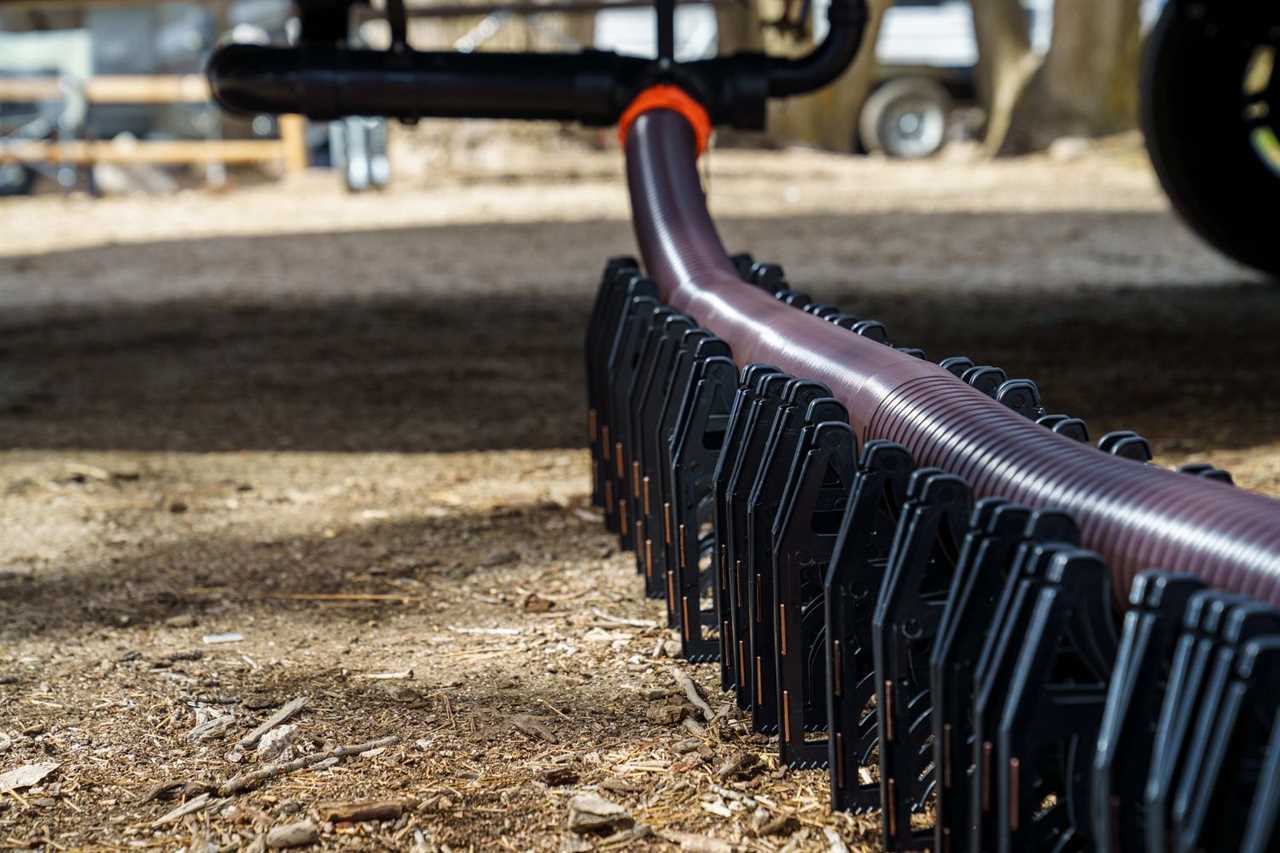
Photo by Camping World
It’s best to wait until your grey and black water holding tanks are completely full to hook up your sewer hose and empty. This reduces how long the valves are open, and heat can escape.
Some RVers enjoying long-term winter stays leave their sewer hose hooked up to an outlet for the duration of their stay. If you do this, only open tank valves when your tanks reach two-thirds of their capacity to empty.
It’s also a good idea to empty your tanks during the hottest part of the day and ensure the hose is empty after dumping. This may require lifting the hose or using sewer hose supports, so it drains completely and minimizes the risk of waste particles freezing in the hose.
How to Prepare Your RV’s Interior for Winter Camping
Winter RV camping should be enjoyable, but that’s tough if you’re perpetually cold. Fortunately, we have plenty of tips to keep your living space warm and cozy throughout the winter.
How to Insulate an RV Floor
Because hot air rises and cold air sinks, floors often feel extra chilly in the morning. Fortunately, there are many ways to insulate under your feet, such as interior rugs and runners, carpet tiles, and floor mats.
View this post on Instagram
A post shared by ♡ RV RENOVATIONS (@lovethatrv)
How to Insulate RV Windows and Doors
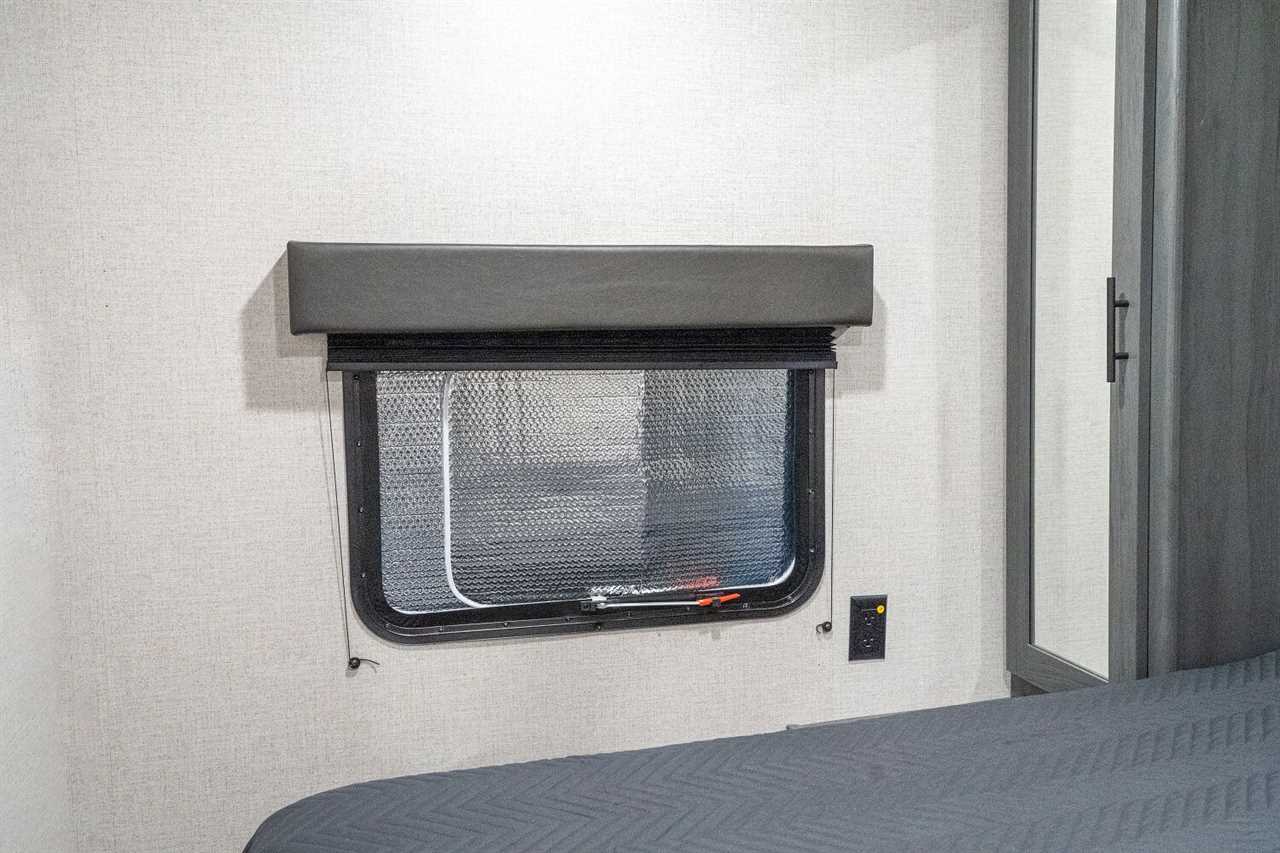
Photo by Camping World
The next two obvious places for heat loss are your RV windows and doors. An RV with dual-pane windows is best for winter camping, but there are ways to insulate single-pane windows if your budget doesn’t allow for that upgrade.
You can add foil insulation to windows and doors to reduce heat loss. If you don’t like that look, you can upgrade to thicker window shades. Door window covers and a reflective sunshade that fits your RV’s front window will also help.
If you can’t find exact matches for all your windows and doors, you can purchase a foil insulation roll and cut squares to the needed dimensions. While you can, most winter RVers don’t cover ALL their RV windows, so they can still enjoy natural light and heat from the sun during the day.
Check out Camping World’s complete selection of insulation, shades, and covers to add to your RV doors and windows.
In addition to adding insulation, check the weather stripping around your RV doors. If it’s partially detached or missing, replace it to keep cold and moisture out.
Technician Tip: Use caution when installing window insulation, so you don’t block the weep holes or cause them to become obstructed with ice. The condensation will back up and run down the walls inside your RV if you’re not careful.
How to Insulate RV Roof Vents
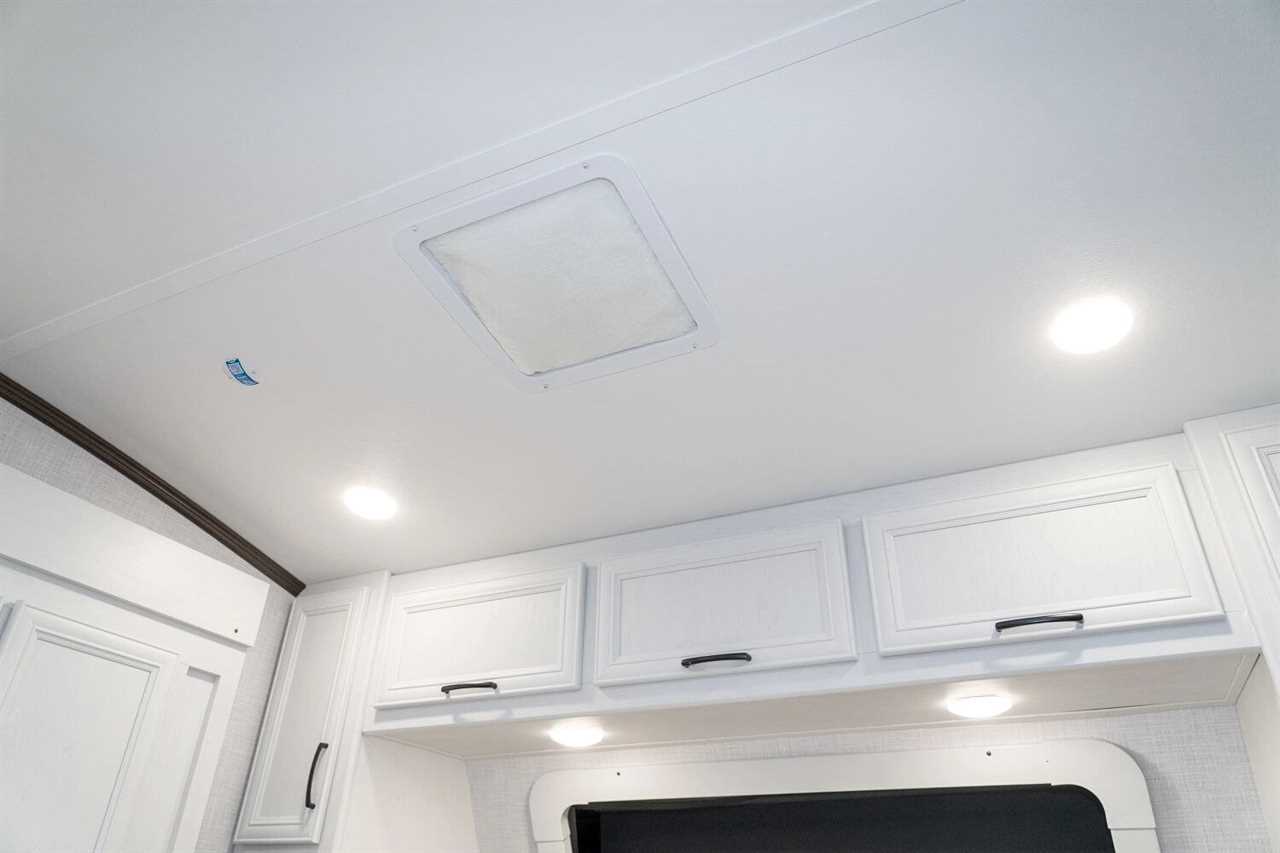
Photo by Camping World
Because you won’t necessarily need these vents for air circulation during the winter, you can install vent cushions to reduce heat loss further.
Vent cushions can also be used during the warmer months to trap cool air from your AC inside your RV, making them an excellent investment for conserving energy. The good news about these cushions is that they can be installed or removed in seconds.
Electric Vs. Propane Heat Sources
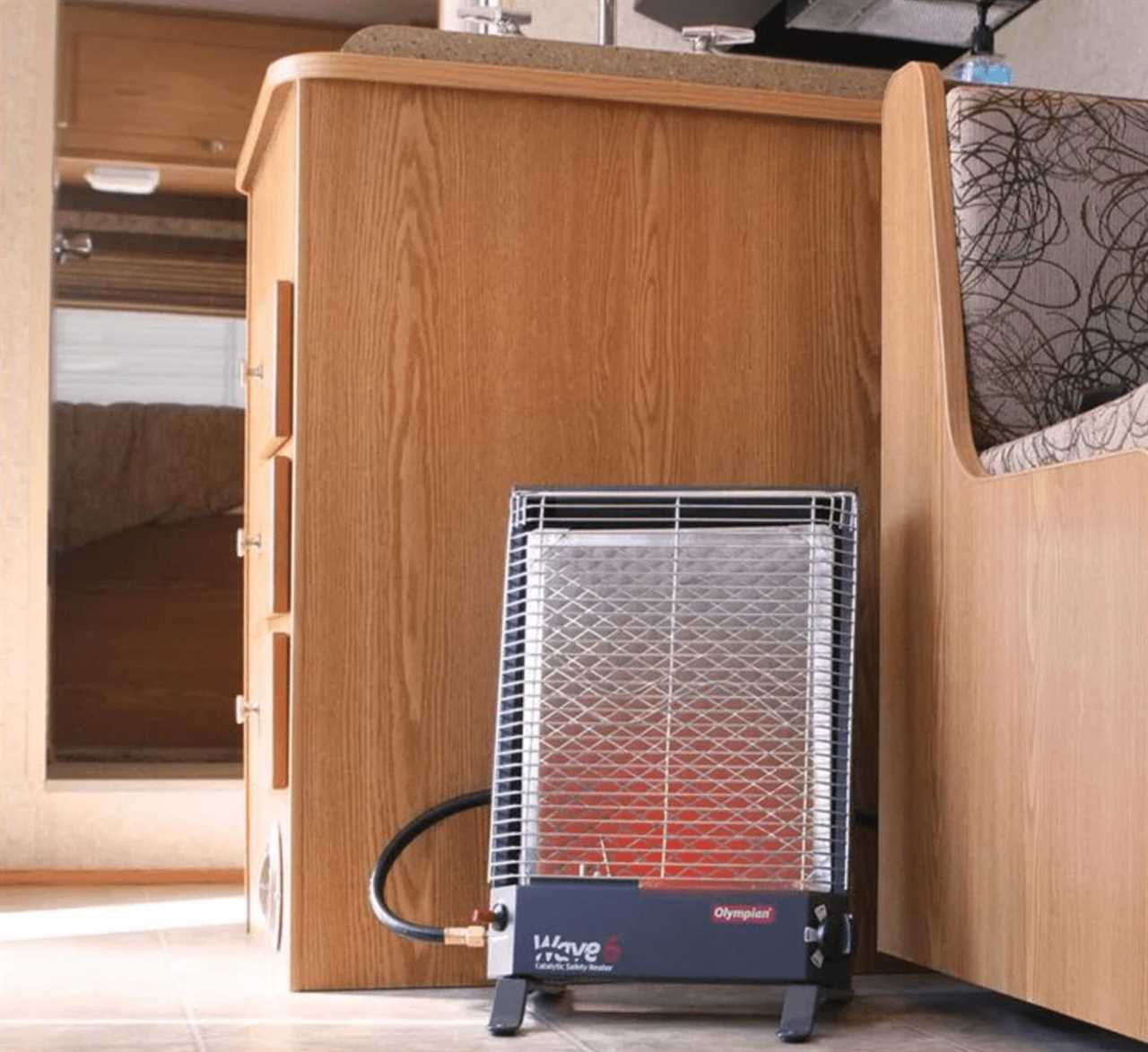
Photo by Camping World
There are three main heat sources to help you stay warm when winter camping. The first is your RV’s propane furnace. Your furnace is the best way to heat the inside and underbelly of your RV efficiently. So, before your winter camping trip, take the time to ensure your furnace is in good working order and check to see if it’s time to replace your furnace filter (if applicable).
Technician Tip: Never install a filter on a furnace that was not equipped with one by the factory.
Use compressed air and a soft brush to remove dirt, dust, and debris from the furnace. Make sure all vents are clean and unblocked. Perform a test by setting your RV thermostat to the desired temperature and measuring its effectiveness with a digital thermometer.
Contact a local Camping World Service Center to schedule a furnace inspection if your furnace isn’t maintaining the desired temperature.
Your second option is a portable electric space heater. Electric heaters can supplement your RV furnace if you’re plugged into AC power all winter. They can even conserve propane and lower your energy bill, depending on the electric costs in your location.
The issue with space heaters is that they heat the living space above the floor, causing the furnace thermostat to switch the furnace off. Only a ducted gas furnace will send heat to your RV’s underbelly. The heated tank spaces are no longer heated if the furnace is off.
Technician Tip: Portable space heaters can overwhelm your coach’s electrical system if used simultaneously with multiple other RV appliances. This may result in inconveniences, damages to the coach, or even fires. Avoid models with a maximum wattage rating over 1,500 watts and turn it off before powering on other high-draw appliances like your microwave.
Your final option is to use a catalytic heater or a portable propane heater that relies on a small propane cylinder. Ensure the unit is safe for indoor use, and stock up on extra propane cylinders if you want this to be a reliable heat source for winter camping.
The issue with propane space heaters is that they can increase condensation and cause a dangerous accumulation of carbon monoxide. They should never be used in a tightly sealed RV, so you’ll need to crack a window and use a dehumidifier to avoid moisture issues.
External Vs. Onboard Propane
When winter camping, you’ll burn propane faster than usual. Your onboard propane container(s) supplies propane to your stove, oven, central furnace, and water heater. Refilling propane is vital to your warmth and comfort when it’s cold outside.
For travel trailers and fifth wheels, propane cylinders can be disconnected and exchanged or refilled at local hardware or grocery stores. Just know that small portable LP containers are subject to refrigeration in cold weather.
Technician Tip: In cold weather, small LP containers seem to run out of gas when they’re only half empty. Keeping your containers above half full is your best bet for reliable propane supply when winter camping.
For motorhomes, however, you’ll need to pay a propane fill service to come to you or move your RV to a fill station, which can be treacherous on winter roads. Some motorhome owners pay for an external propane tank to be installed outside. This requires a propane adapter kit and a propane company to deliver and attach the tank.
Call multiple propane providers in your area to compare prices and services. If given the option of “Keep Full” or “On Call” service, “Keep Full” eliminates the hassle of running out of propane because you forgot to check the level regularly.
How to Protect the Outside of Your RV
From getting snow off the roof to ensuring your stabilizing jacks don’t freeze to the ground, there are some important steps to protect your RV’s exterior on winter adventures.
How to Insulate an RV Underbelly
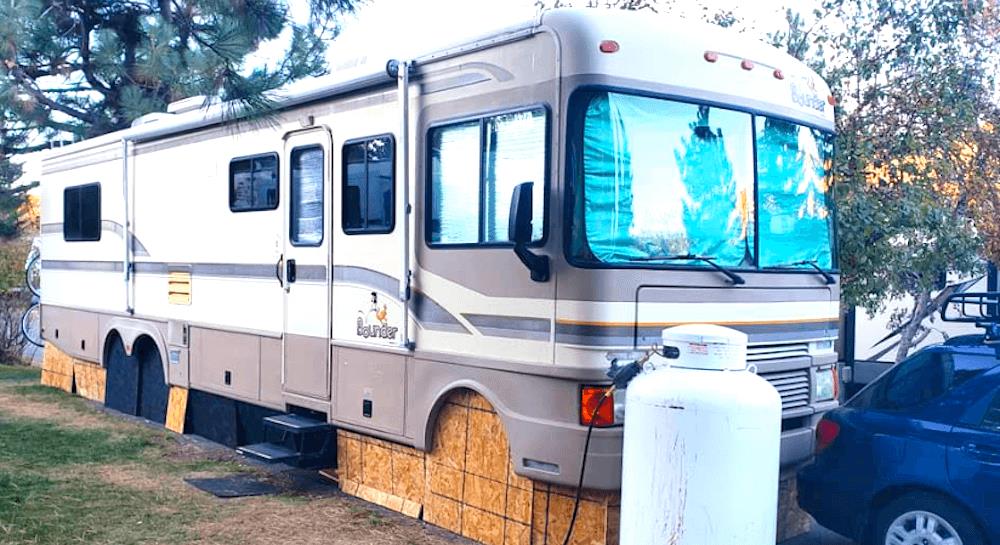
Photo by Tucker Ballister
To keep RV stabilizing jacks from freezing to the ground, place wooden blocks, leveling blocks, or stabilizing jack pads beneath them. If you store recreation items under your RV, place them on a tarp or in sealed bins to avoid water damage.
Using an RV skirt provides another level of insulation for the open space beneath your RV. A skirt can keep your floors, holding tanks, and vehicle components warmer when outside temperatures drop below freezing. Portable or long-term insulated skirting makes a massive difference in comfort and efficiency. Any warmth you can trap inside your RV or underbelly works to your advantage.
An added benefit of skirting your RV is protected exterior storage. If you have kayaks or bikes that don’t have anywhere else to go, slide them under your RV before skirting to keep them out of the elements.
Technician Tip: RV skirting can make an attractive home for critters. Use insect and rodent deterrents to keep them at bay throughout the winter.
How to Make Exterior RV Steps Safer

Your convenient RV step can quickly turn into a slippery hazard in freezing temperatures. The best way to add grip is to install wraparound step rugs. You can also install an external handrail for added safety when entering and exiting your RV in the winter.
Technician Tip: Choose step rugs carefully. The open styles with aggressive textures are best for winter camping, as the carpet-styles can still turn icy in cold, wet weather.
Inspecting RV Window Seals
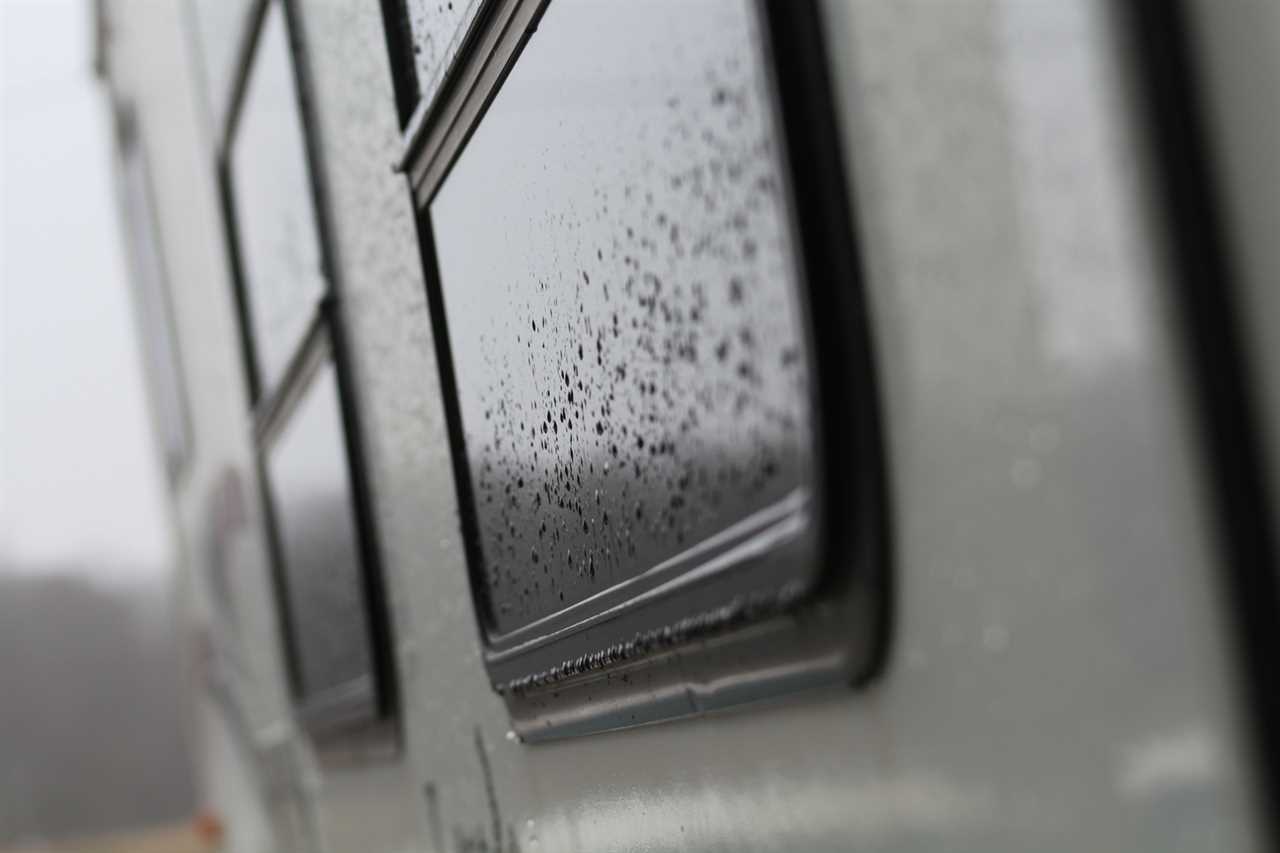
Photo by Aaron Rapps Photos via Shutterstock
You should also check the status of your RV’s exterior window seals. If you haven’t addressed them in a few years, adding caulk or sealant might be helpful before winter camping. Many of these products have temperature limits that must be observed, so check the manufacturer’s instructions to ensure proper use.
There are several caulk and sealant products for resealing around your RV windows. Ideally, find a non-sagging or quick-drying product so you can do this job quickly without making too much of a mess.
Consult your owner’s manual for recommendations on compatible sealant products for your RV.
Protecting your Roof, AC, Slide-Outs, and Awnings
Avoid snow and ice accumulation anywhere on your RV. No matter how cold it is, the best way to protect your RV when winter camping is to push the snow off after each storm. This includes your slideouts, and you can use slide-out supports to protect them from the added weight of snow and ice.
Technician Tip: Your best bet in heavy snow events is to close slide-outs until the storm passes.
When removing snow and ice, be careful to avoid damaging your roof or awnings. We recommend a broom with soft bristles to clear a light dusting of snow. For larger accumulations, use a plastic shovel to clear the top layer before pushing the bottom layer off with the broom.
Climbing up your RV ladder can be the most dangerous part of this effort. Shoes with soft rubber soles are best for handling slippery surfaces, and you should also ask a partner or friend to spot you if possible, but be aware that a harness and fall protection are the only true ways to guarantee your safety when climbing on a fully walkable RV roof.
We also want to note that it’s best to leave your main RV awning closed when winter RV camping. Weight from snow and ice and the potential for high winds make the risk for awning damage high in the winter.
If your awning is damaged, consult your guide to RV awnings for information on removal, installation, and awning fabric replacement.
Lastly, consider installing a cover over your A/C unit because you most likely won’t use it in the winter. An insulated A/C cover protects the unit from damage while keeping out those dreadful winter drafts.
Technician Tip: DO NOT install an A/C cover when your coach is in use if your units have a heat pump.
Driving Tips for Winter RV Camping
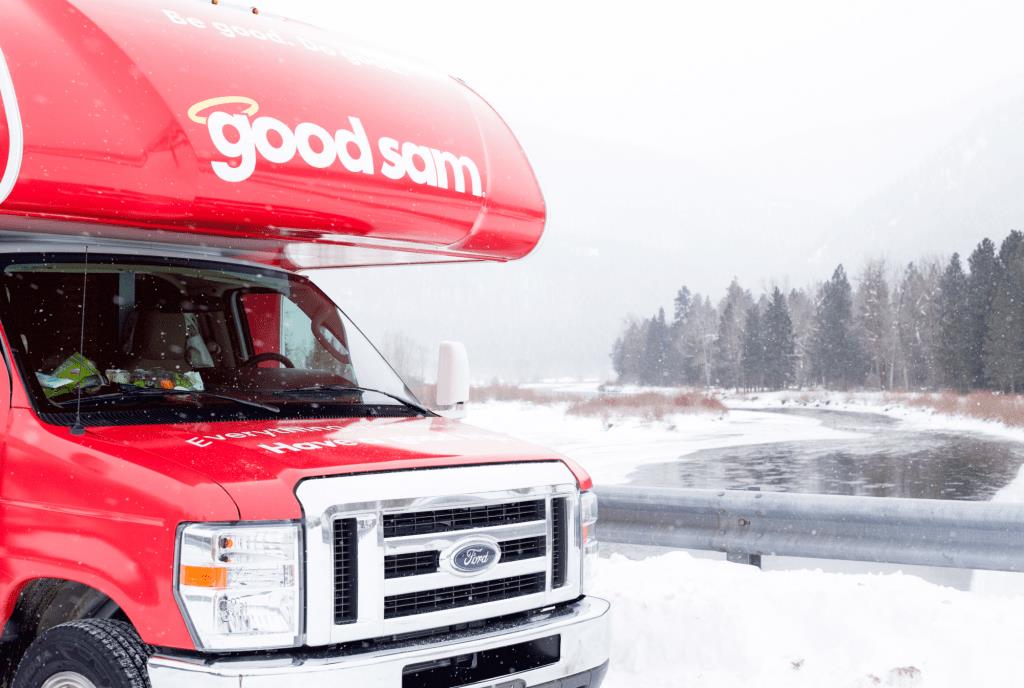
Good Sam Roadside Assistance always ensures you’re never alone on the road.
If you aren’t full-time winter camping in one place, you’ll need to navigate wet, slippery roads between destinations. Here are a few tips for safe winter RV driving:
- Get all-weather tires.
- Check the weather early and often, especially when navigating mountain passes.
- Accelerate and decelerate more slowly than normal.
- Avoid quick lane changes and turns, which are always bad ideas in an RV.
- If chain restrictions are in place, don’t go.
- Consider investing in traction boards to help you self-rescue if you get stuck.
- If you feel uncomfortable with the weather conditions, stay put.
- Slow and steady wins the race.
Enroll in Good Sam Roadside Assistance to know help will be on the way if needed!
Camping in the winter can be an exciting adventure and allow you to enjoy all the fun that snowy destinations offer. When you get home, winterize your RV properly, so your RV doesn’t have any trouble weathering those frosty winter storms.
Do you have experience camping in cold weather? Share your advice with fellow RVers in the comments below!
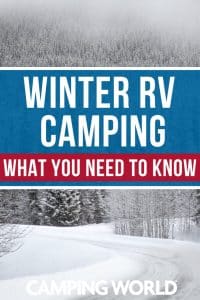
By: Jessica Baker
Title: Winter RV Camping: What You Need to Know
Sourced From: blog.campingworld.com/at-the-campsite/winter-rv-camping-what-you-need-to-know/
Published Date: Wed, 14 Dec 2022 15:00:51 +0000
---------------------------------------------
 CampingSurvivalistHuntingFishingExploringHikingPrivacy PolicyTerms And Conditions
CampingSurvivalistHuntingFishingExploringHikingPrivacy PolicyTerms And Conditions
